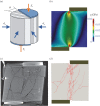Understanding hydraulic fracturing: a multi-scale problem
- PMID: 27597789
- PMCID: PMC5014299
- DOI: 10.1098/rsta.2015.0426
Understanding hydraulic fracturing: a multi-scale problem
Abstract
Despite the impact that hydraulic fracturing has had on the energy sector, the physical mechanisms that control its efficiency and environmental impacts remain poorly understood in part because the length scales involved range from nanometres to kilometres. We characterize flow and transport in shale formations across and between these scales using integrated computational, theoretical and experimental efforts/methods. At the field scale, we use discrete fracture network modelling to simulate production of a hydraulically fractured well from a fracture network that is based on the site characterization of a shale gas reservoir. At the core scale, we use triaxial fracture experiments and a finite-discrete element model to study dynamic fracture/crack propagation in low permeability shale. We use lattice Boltzmann pore-scale simulations and microfluidic experiments in both synthetic and shale rock micromodels to study pore-scale flow and transport phenomena, including multi-phase flow and fluids mixing. A mechanistic description and integration of these multiple scales is required for accurate predictions of production and the eventual optimization of hydrocarbon extraction from unconventional reservoirs. Finally, we discuss the potential of CO2 as an alternative working fluid, both in fracturing and re-stimulating activities, beyond its environmental advantages.This article is part of the themed issue 'Energy and the subsurface'.
Keywords: discrete fracture network; hydraulic fracturing; lattice Boltzmann; microfluidics; shale gas; subsurface flow and transport.
© 2016 The Author(s).
Figures






Similar articles
-
Introduction: energy and the subsurface.Philos Trans A Math Phys Eng Sci. 2016 Oct 13;374(2078):20150430. doi: 10.1098/rsta.2015.0430. Philos Trans A Math Phys Eng Sci. 2016. PMID: 27597784 Free PMC article.
-
Study of gas production from shale reservoirs with multi-stage hydraulic fracturing horizontal well considering multiple transport mechanisms.PLoS One. 2018 Jan 10;13(1):e0188480. doi: 10.1371/journal.pone.0188480. eCollection 2018. PLoS One. 2018. PMID: 29320489 Free PMC article.
-
Investigation of Fracturing Fluid Flowback in Hydraulically Fractured Formations Based on Microscopic Visualization Experiments.Polymers (Basel). 2023 Mar 21;15(6):1560. doi: 10.3390/polym15061560. Polymers (Basel). 2023. PMID: 36987341 Free PMC article.
-
Chemical and Reactive Transport Processes Associated with Hydraulic Fracturing of Unconventional Oil/Gas Shales.Chem Rev. 2022 May 11;122(9):9198-9263. doi: 10.1021/acs.chemrev.1c00504. Epub 2022 Apr 11. Chem Rev. 2022. PMID: 35404590 Review.
-
Review of the scientific evidence to support environmental risk assessment of shale gas development in the UK.Sci Total Environ. 2016 Sep 1;563-564:731-40. doi: 10.1016/j.scitotenv.2015.11.026. Epub 2015 Nov 26. Sci Total Environ. 2016. PMID: 26627123 Review.
Cited by
-
Quantifying Topological Uncertainty in Fractured Systems using Graph Theory and Machine Learning.Sci Rep. 2018 Aug 3;8(1):11665. doi: 10.1038/s41598-018-30117-1. Sci Rep. 2018. PMID: 30076388 Free PMC article.
-
Widespread deep seismicity in the Delaware Basin, Texas, is mainly driven by shallow wastewater injection.Proc Natl Acad Sci U S A. 2021 May 18;118(20):e2102338118. doi: 10.1073/pnas.2102338118. Proc Natl Acad Sci U S A. 2021. PMID: 33972450 Free PMC article.
-
Research and application of rock fracturing pressure prediction method for deep oil reservoirs.Sci Rep. 2025 Mar 25;15(1):10182. doi: 10.1038/s41598-025-94764-x. Sci Rep. 2025. PMID: 40128323 Free PMC article.
-
Interaction of natural and hydraulic fractures: the impact on reservoir pressure buildup and risk of shear fault reactivation in the Upper Devonian Duvernay Formation, Fox Creek, Alberta.Geomech Geophys Geo Energy Ge Resour. 2023;9(1):21. doi: 10.1007/s40948-023-00537-z. Epub 2023 Feb 27. Geomech Geophys Geo Energy Ge Resour. 2023. PMID: 36875936 Free PMC article.
-
Introduction: energy and the subsurface.Philos Trans A Math Phys Eng Sci. 2016 Oct 13;374(2078):20150430. doi: 10.1098/rsta.2015.0430. Philos Trans A Math Phys Eng Sci. 2016. PMID: 27597784 Free PMC article.
References
-
- Moniz EJ. et al. 2011. The future of natural gas. Cambridge, MA: Massachusetts Institute of Technology.
-
- Middleton RS, Carey JW, Currier RP, Hyman JD, Kang Q, Karra S, Jiménez-Martínez J, Porter ML, Viswanathan HS. 2015. Shale gas and non-aqueous fracturing fluids: opportunities and challenges for supercritical CO2. Appl. Energy 147, 500–509. (10.1016/j.apenergy.2015.03.023) - DOI
-
- Birdsell DT, Rajaram H, Dempsey D, Viswanathan HS. 2015. Hydraulic fracturing fluid migration in the subsurface: a review and expanded modeling results. Water Resour. Res. 51, 7159–7188. (10.1002/2015WR017810) - DOI
-
- McGlade C, Speirs J, Sorrell S. 2013. Methods of estimating shale gas resources—comparison, evaluation and implications. Energy 59, 116–125. (10.1016/j.energy.2013.05.031) - DOI
-
- Viswanathan HS. et al. 2015. Integrated experimental and computational study of hydraulic fracturing and the use of alternative fracking fluids. In 49th US Rock Mechanics/Geomechanics Symp. Alexandria, VA: American Rock Mechanics Association.
Publication types
LinkOut - more resources
Full Text Sources
Other Literature Sources

